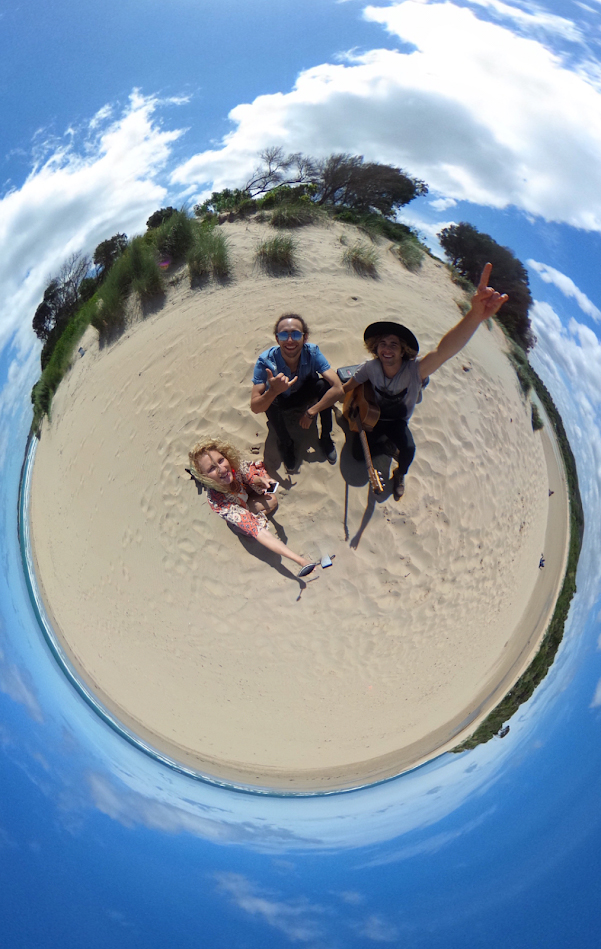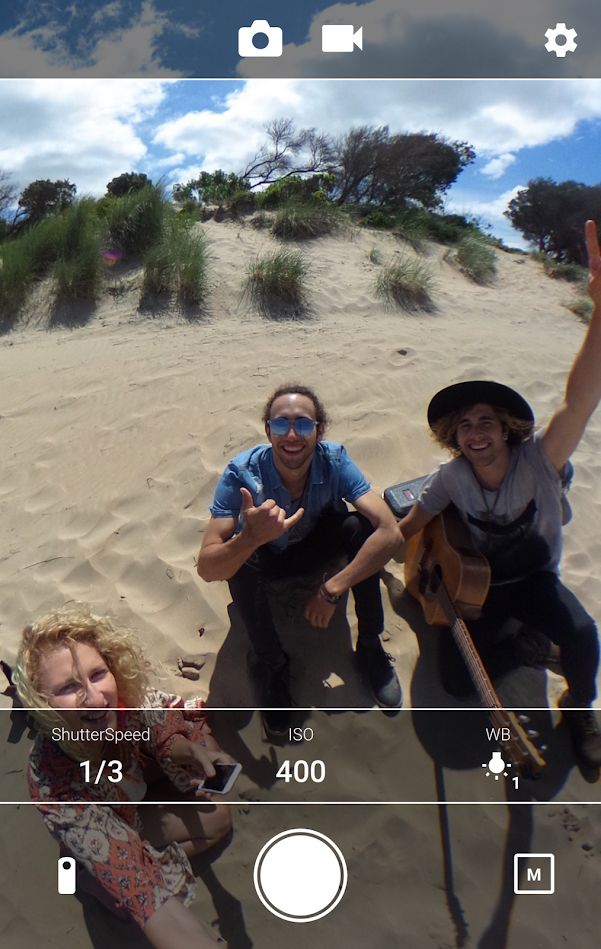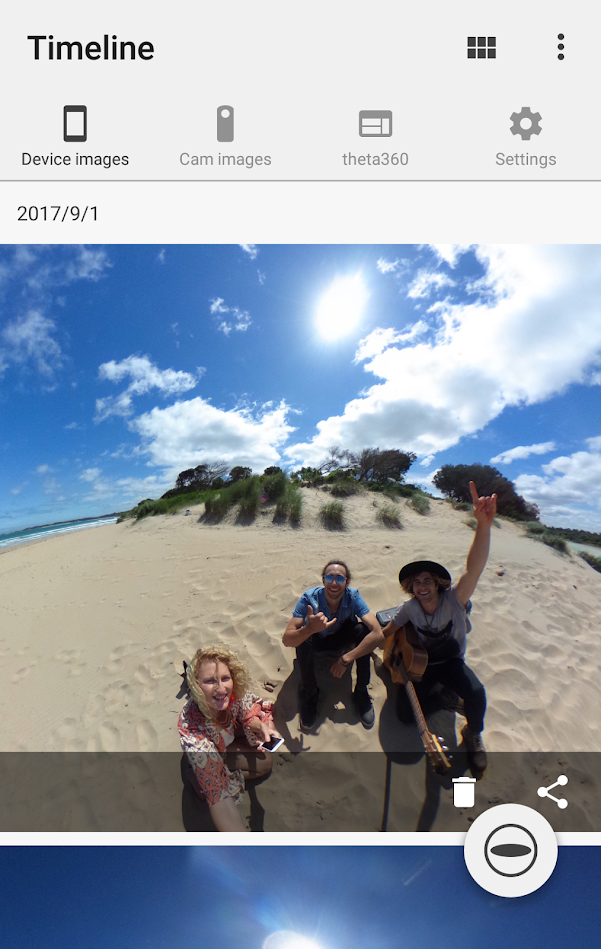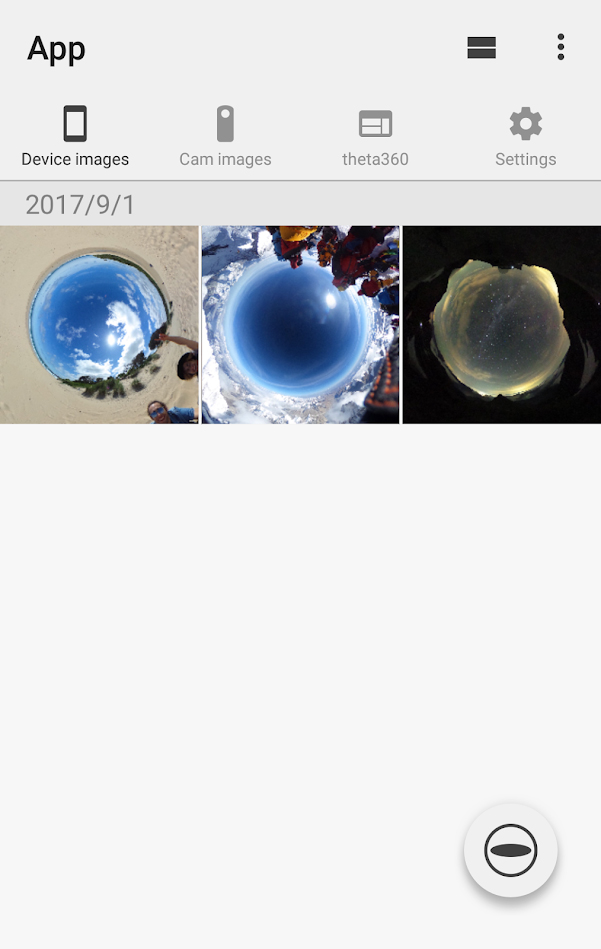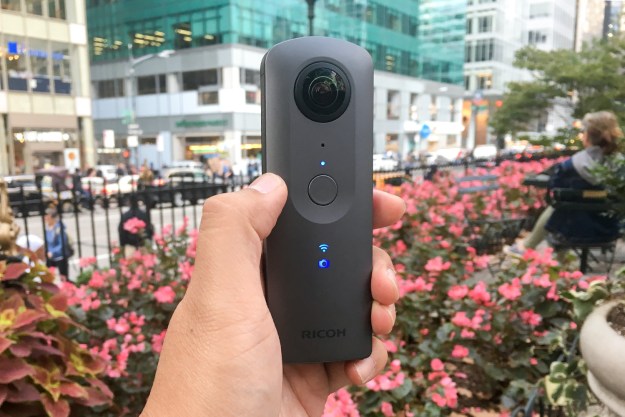
“The Ricoh Theta V is the best 360-degree camera for everyday consumers.”
- Simple to use
- Tried-and-true design
- Spatial audio
- Good image quality
- Faster performance
- App could use an update
- Wireless casting isn’t straightforward
- Built-in storage capacity is small
- No optical image stabilization
For a time, it seemed the market was glutted with 360-degree cameras. This newfangled technology was hailed as the next big thing in cameras. When Facebook and YouTube added support for 360-degree media, it seemed everybody would be taking photos and videos in the format moving forward.
Things have simmered down. We don’t see any many new camera introductions as in years past (or maybe, we just stopped looking). While there are some unique benefits, and there’s certainly a future for the medium, consumers haven’t exactly gravitated toward 360-degree cameras for a variety of reasons: High price, poor image quality, and awkward usability, to name a few.
One pioneer in this space is Ricoh with its Theta series. Like many 360-degree cameras, it also had some teething issues. But over time, image quality improved and more features were added. The Theta V, the latest in the lineup, is the best Theta yet. It’s extremely easy to use, and stills and videos are some of the best to come out of a two-lens camera. But Ricoh amped up the performance, thanks to the addition of new sensors and processors, and there are unique features like spatial audio and wireless casting. It’s still on the pricier side, at $470, but it feel more polished than many cheaper alternatives.
The Theta-series has been able to hold its own, despite numerous competing cameras that do the same thing. But with the arrival of the GoPro Fusion and Rylo — two cameras that combine great hardware and software to reframe 360 content for standard, fixed-frame output — is there a place still for the Theta? We’d say there is, because even though consumers can find more advanced cameras, nothing beats the Theta V when it comes to ease of use. And when it comes to capturing life in 360, sometimes less is better.
Tried and true design
From a design perspective, there’s a reason why products like the Apple iPhone keep recycling the look and feel of previous models. This applies to the Theta V, which looks nearly identical to all the older Thetas. The only noticeable difference is that it has a lighter shade of metal gray, versus the darker Theta S and more colorful Theta SC.
The Theta V isn’t the most advanced 360 camera, but nothing beats it when it comes to ease of use.
You could argue this is a lazy approach to design, but we disagree: When you have a form-factor that looks good and functions very well, you should stick with it. There’s a reason why DSLRs pretty much look alike. That’s not to say there couldn’t be a better design, but judging from all the weird-looking 360-degree cameras that we’ve played with, it’s actually refreshing Ricoh is sticking with something that’s tried and true.
And we’ve always appreciated the slim-and-tall design that fits comfortably in the hand like a TV remote. There are few buttons to press — wireless on/off button, power, mode, and shutter — making it one of the most simple 360 cameras to operate. No, you don’t have the ability to adjust more advanced settings, like you would with the Samsung Galaxy Gear 360 (you would need to use the Theta app for iOS or Android), but that just means it’s easier and faster to use.
The design also makes it easy to hold and keeps your fingers away from the lens. As with other 360 cameras, you’ll still want an extra hand grip, like our trusty PolarPro Trippler Tripod, to get the cleanest shot, however.
The Theta V measures approximately 1.8 (width) x 5.1 (height) x 0.9 (depth) inches, which is just a tad wider and taller than the Theta S; otherwise, they feel the same. It’s lightweight, at approximately 4.3 grams, making it easy hold in the hand or pocket.
On the side that faces the user, with the shutter button, there are LED status indicators that let you know if it’s recording, what mode you are in (photo or video), when storage is almost full, and if it’s connected via Wi-Fi. New for the Theta V is an indicator for live streaming (up to 4K), although this function is somewhat limited.
What’s not noticeable is that the Theta V now has two microphones at the top, plus two on either side of the camera. This is due to the camera’s ability to capture not only higher-quality audio, but also in 360 degrees (spatial). Basically, you get a more accurate sound reproduction, and an immersive experience when viewing through a headset and listening with headphones. The speaker, which used to be at the top in previous Thetas, is now on the side.
Design wise, Ricoh is sticking with something that’s tried and true.
At the bottom, Ricoh has removed the HDMI-out port in favor of a new microphone terminal. This is where you attach the optional TA-1 3D microphone accessory, which allows you to record 360-degree spatial audio (we’ll come back to this below). Also at the bottom is a standard tripod mount and USB jack for power and connecting to a computer.
Construction is solid, but one word of caution: Despite ensuring we kept the camera in a protective cloth bag or hard case when not in use, Ricoh told us our review sample ended up receiving a scratch on the lens, after we returned it. Unfortunately, there’s no way to replace the outer part of a lens, but Ricoh does offer a new hard case that protects the entire unit.
4K video, higher sensitivity, improved connectivity
Although the Theta V’s camera resolution hasn’t changed — two 12-megapixel sensors matched to f/2 lenses — a lot of what’s inside has. Image quality remains at 5,376 x 2,688 pixels, but ISO has increased to 3,200 and maximum shutter speed is 1/25,000 of a second, versus ISO 1,600 and 1/6,400 of a second with the Theta S. The 1/2.3-inch sensors are also newly developed for the Theta V, and have faster readout that previous sensors.
From our testing, the camera’s photo hasn’t changed dramatically, although we were able to shoot some usable low-light photos. The big change is in video: The Theta V can now do 4K at 3,840 x 1,920 at 30 frames per second (fps), versus Full HD 1,920 x 1,080 at 30 fps. It can also live-stream in
Audio capture is also improved, since multiple mics are able to record spatial stereo sound rather than the single mic of previous models. In truth, when it comes to onboard mics, we don’t have big expectations, but the Theta V’s sound quality is better than what we’re used to. Still, Ricoh knew it could do even better, so it added support for an external 3D microphone it designed in partnership with Audio-Technica. The TA-1 adds some bulk and weight to the Theta V — not to mention it also draws power from it — but not only can it capture better sound quality, it does it in 360 degrees. And when you pan around the scene, the sound changes accordingly — as it would sound in real-life. It makes for a much more immersive experience when viewing through a headset and listening with headphones.
Much of the performance upgrade is thanks to a Snapdragon processor.
We didn’t test the TA-1 during our review period, but we did check out some demos during a briefing last year. Sound quality is noticeably better, and when we listened to it through headphones while watching, we did experience that spatial quality. Whether it’s worth an extra $270 is up to you, but note that YouTube is currently the only service that supports 360-degree videos with spatial audio.
Much of the performance upgrade is thanks to a Qualcomm Snapdragon processor, and it’s the first time Ricoh has added one to a Theta camera. Ricoh says the image processing in the Theta V is 10-times faster than the Theta S, and it was noticeably faster during our review. For example, it doesn’t take as long to save a photo or video. The Theta V also has a new gyro for precise movements.
As noted, the Theta V offers 4K live steaming, but it’s not as easy as it might sound. With many 360-degree cameras, you can go live on YouTube or Facebook, in 360, directly from the camera’s smartphone app. The Theta V, however, does not support either natively. To initiate a live broadcast, you have to connect the camera to a computer via USB (Windows only), and follow a somewhat convoluted series of steps to stream it to YouTube. We found the whole process daunting, and more involved that it needs to be — especially for a camera that is otherwise so easy to use. If live streaming is a feature you want, the Theta V should not be your first choice.
For wireless connectivity, Ricoh added Bluetooth. When connected to a smartphone, Bluetooth lets you quickly pair the two devices (it technically maintains a constant connection), use a remote shutter, change settings, and add location information. For a live-view image and transferring files, the camera switches over to Wi-Fi. Bluetooth draws less energy than Wi-Fi, but it can’t support the more demanding tasks that Wi-Fi can. You can also pair the camera with a phone via a home network (client mode).
We didn’t encounter any issues when using the app and camera. The live-view image was clear and never lagged, although live-view isn’t available when shooting in 4K. Because it’s shooting in 360, you don’t really need to see what you’re recording, although it’s useful for your opening shot. The app itself, however, hasn’t really evolved. There are some basic settings you can adjust, you can review content, and upload to compatible social media. It’s not extensive, but it’s simple to use and it works. However, it lacks the cool features that GoPro and Rylo have implemented on the software side. (Ricoh has additional apps for Theta that let you edit on a mobile device.)
The Theta V has 19GB of built-in storage, which isn’t a lot considering the storage demands of 4K video. And, if there’s a con to the design, it’s that you can’t add more storage by way of a memory card. On the plus side, the Theta V supports external hard drives, so you can offload the content that way, which is faster than wireless transfers.
Remote playback on a TV, third-party development
As mentioned, an HDMI port has been removed to make way for a mic input. We don’t know many consumers who connect their cameras to a TV, but if you are one of them, Ricoh added a way to wirelessly cast content from the camera.
To do this, you need an adapter that supports the Miracast protocol. Ricoh lists the Amazon Fire TV Stick (2017), Microsoft Wireless Display Adapter V2, and Screenbeam Mini2 as compatible devices. Once it’s connected, you can browse through the content in the camera, on the TV. Because of the gyro sensor in the camera, you can use it as a remote to control the onscreen cursor.
It seems like a nice solution, but it’s not as elegant as we would like. The connection can be slow, and since not all consumers own a Miracast-compatible device, it’s not a universal feature (at least, Fire TV Sticks aren’t very expensive). And, the playback content is only at 1,280 x 720 resolution. When it works, it works. But in our eyes, it’s not a highlight feature.
With the Theta S, Ricoh created a program that allowed third-parties to develop apps that work with the camera, via a software development kit (SDK). Earlier this year, at the Consumer Electronics Show, Ricoh announced a similar program for the Theta V. Third-party developers could access the Theta V’s application program interface and SDK to build plug-ins and apps. The Miracast feature is actually a plug-in that Ricoh developed as a proof of concept; the idea is that users, in the future, can download new features onto the camera.
Although it is a good idea, it remains to be seen what types of programs would be developed. With the Theta S, there weren’t exactly a lot to choose from, and the Theta V may encounter the same issues. We won’t discount this feature, however.
Image quality
As we’ve said about other 360-degree cameras, it’s a technology that’s looking for an audience. At the professional level, there are lots of impressive multi-lens cameras that capture great image quality. But when you have a two-lens setup, you can only do so much.
However, the Theta V manages to shoot some nice-looking images. The Theta S was already great at this, and the Theta V continues the trend. In general, under favorable lighting conditions outdoors, still image quality looks very good, with nice color reproduction. Exposure is nicely balanced, and the Theta V does a very good job at stitching the two 180-degree images together. It’s not without issues: You will notice some areas of color fringing and noise, particularly indoors where you have challenging lighting. But overall, we think the Theta V is one of the better 360-degree cameras for photos.
While we didn’t have high expectations for low-light photography, we were impressed with our results. Sure, there’s noise and not much dynamic range, but our photos didn’t look bad at all. And when it’s all about capturing the moment, any deficiencies in image quality could be forgiven.
Video is big improvement over the Theta S. With 4K and the new components, video quality is much more pleasing to watch than before, provided you’re shooting
We know many 360-degree cameras aren’t known for their image quality. After all, it’s the spherical experience you’re after. But despite the issues, the Theta V does a good job with both stills and videos, as well as overall stitching. For a consumer 360 camera, we think the Theta V is a well-rounded product.
Warranty information
Ricoh offers a standard one-year warranty.
Our Take
With 360-degree cameras, it’s always a challenge. No matter how great the product is, like the Rylo and GoPro Fusion, it’s not a must-have technology. This applies to the Theta V: Overall, it’s a very good camera that’s easy to use, and it’s ideal for travelers or anyone looking for a camera that shoots basic 360-degree photos and videos. Do you need it? Hardly.
But, if you’re looking for a new way to tell a story, you can’t go wrong with a spherical camera. You don’t need to keep your expectations low, but as long as you’re aware of the limitations, a 360-degree photo and video can be a fun way to express your creativity or add a twist to a video workflow.
Case in point: A friend asked us to show him some photos from a recent vacation, but instead of sending JPEGs or links to Instagram, we sent 360-degree photos (Theta website) and videos (YouTube). The response was overwhelmingly receptive, as we were able to give more impactful visuals. It worked in this instance, but 360-degree content isn’t always ideal.
The Theta V is one of the more enjoyable 360-degree cameras we’ve used. At $470, it’s not the cheapest, but it’s far from the most expensive. Sure, there are some feature we would never use, but overall good image quality and spatial sound make it a standout product. We can’t say any 360-degree camera is a must-buy, but if you’re in the market for one, you won’t go wrong with the Theta V.
Is there a better alternative?
For the budget-conscious, the 4K-capable Samsung Galaxy Gear 360 is a nice alternative. It can be found for less than $120, and it has some features the Theta V lacks, like a small LCD, memory card slot, and live broadcasting to YouTube and Facebook. It’s also easy to use, and compact. If you want a 360-degree camera as a novelty, the Gear 360 is good for dipping your toes in the water, without spending a lot. But if image quality matters more, you’re better off with the Theta V.
Advanced users might find the Theta V lacking, and should look at the Rylo or GoPro Fusion. Those cameras aren’t only great hardware, but they come with software that takes advantage of what 360-degree cameras can do. The Theta V is really targeted toward casual users, but the spatial audio makes it unique.
How long will it last?
The Theta V is well made, but users should exercise some care when handling it. Ricoh appears to be on a yearly refresh, and while it’s possible Ricoh will introduce a new Theta later this year, we don’t believe it will be a significant upgrade over the Theta V.
Should you buy it?
If you’re looking to capture a unique perspective, the Theta V gives you that. It’s easy to use, and it delivers good image quality. It’s a fun tool to use during travels or special events, or you can contribute to Google’s Street View by uploading your photos of exotic locales. Do you need it? No, no consumer 360 camera is a must buy right now. But if your budget allows and you’re looking for a new way to tell a story, a 360-degree camera is useful in that regard — and the Theta V is one of the better options.
Editors' Recommendations
- The four-lens Vecnos Iqui is a 360 camera unlike any other
- Fujifilm X100V vs. X100F: Should you upgrade to Fujifilm’s newest rangefinder?
- The Fujifilm X100V is loaded with tech it doesn’t need — and that makes it great




